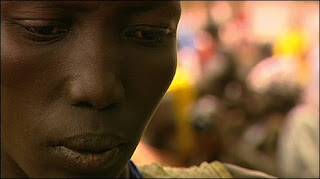
This is a really great
site about Nigeria and the food eaten there. I found it off of the Google home page. It contains information about what they eat for certain meals and how it is prepared, giving you the recipes. The site is maintained by 'Food in Every Country' and was last updated in 2010. The site tells what people eat in certain areas of the country and what is common throughout. Since we just finished reading the book
Things Fall Apart I will be comparing that to the article as well.
I wanted to look up something that related to
Things Fall Apart so I decided to research the foods in Nigeria and compare them to the ones talked about in the book. Nigeria has a wide variety of ethical diversity, in fact one of the most diverse in the world. The Ibo people make up 18% of the country. The clan of people in
Things Fall Apart are also Ibo. The site stated that rice, millet, and lentils were the main foods before trading started. Since Nigeria lies in the tropics fruits are available. Oranges, melons, grapefruits, limes, mangoes, bananas, and pineapples are popular. In the eastern part of Nigeria, where the Ibo clan was from, they eat dumplings, pumpkins, and yams. Yams are very important to their diets. It's kind of like potatoes to us in the United States. Yams are pale and not very sweet. Fish is also important to the Nigerian diet since they only get protein from a couple other foods. Stews are also eaten, they're typically spicy and eaten with rice, yams, corn, and cassava.
This article caught my attention because the food they eat is so different from what we eat in the United States. Everything they eat seems so plain and bare compared to here. I thought it was interesting that fish is one of their few sources of protein. They don't eat many other meats. This article connected to what we are learning in African Cultures and the book
Things Fall Apart because in the book I learned that yams are a huge part of the Ibo culture. The Feast of the New Yam was held every year before the harvest began, to honor the earth goddess and the ancestral spirits of the clan in the book. Also, soups were eaten and palm-wine was drank often.
Nigerians eat breakfast at around 5 A.M. and lunch around 11 A.M. Lunch is the most important meal of the day and is only one course. If they eat soup they cup their right hand into the shape of a spoon and eat out of it. As I read on through this article it talked about the holidays and what was eaten at holiday gatherings. Roasted goat, pounded yams, and chopped liver seemed to be the main dishes. These foods are very similar to the book. If someone made a mistake or did something that would displease a God, a chicken or goat was often sacrificed.
I found this site very fascinating and it really relates to the book
Things Fall Apart. It helped me learn more about the country of Nigeria and what it's like to live their. The foods may be totally different but the people are still the same, full of life and energy.
Picture courtesy of Google.

 This picture is of a mother struggling to feed her child.
This picture is of a mother struggling to feed her child.  Serena has helped with the construction of schools in Kenya, Senegal, and South Africa. She has also provided student grants and joined the fight against malaria in Ghana. "It is my goal to open many schools for thousands of children who do not have the opportunity to get good education. I plan to do one every year," said Serena. In November of 2008 on her first trip to Kenya she authorized her first school in the Nairobi area. Almost 3/4 of the local population is under the poverty line. "Without education, life is going to be very difficult. My parents always stressed the importance of getting an education and I hope I am bring to fruition their word by opening this school to the community of Wee," said Serena.
Serena has helped with the construction of schools in Kenya, Senegal, and South Africa. She has also provided student grants and joined the fight against malaria in Ghana. "It is my goal to open many schools for thousands of children who do not have the opportunity to get good education. I plan to do one every year," said Serena. In November of 2008 on her first trip to Kenya she authorized her first school in the Nairobi area. Almost 3/4 of the local population is under the poverty line. "Without education, life is going to be very difficult. My parents always stressed the importance of getting an education and I hope I am bring to fruition their word by opening this school to the community of Wee," said Serena.
 All face and head ornaments for African rituals and ceremonies are put into one of four categories: the ancestor spirit, the mythological hero, the combination of ancestor and hero, and the animal spirit. African masks most times stand for a spirit and it's believed that the one wearing the mask is possessed by the spirit of the ancestor. Family pride can be shown by masks of human ancestors or animals that a family or clan can trace their ancestry back to. Dance is usually included when masks of Africa are used. Some examples of dance rituals that include African masks are: agricultural festivals, rituals for increase (money, property, children), rituals for rites of passage, ancestor cults, and fertility rites.
All face and head ornaments for African rituals and ceremonies are put into one of four categories: the ancestor spirit, the mythological hero, the combination of ancestor and hero, and the animal spirit. African masks most times stand for a spirit and it's believed that the one wearing the mask is possessed by the spirit of the ancestor. Family pride can be shown by masks of human ancestors or animals that a family or clan can trace their ancestry back to. Dance is usually included when masks of Africa are used. Some examples of dance rituals that include African masks are: agricultural festivals, rituals for increase (money, property, children), rituals for rites of passage, ancestor cults, and fertility rites.



